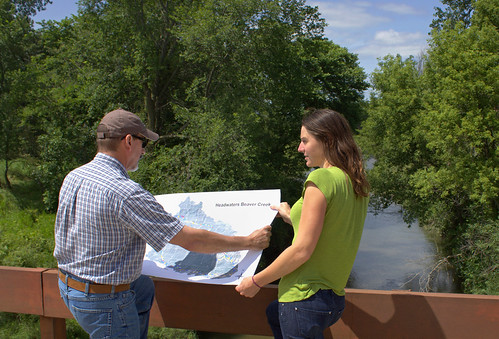
Along Beaver Creek in central Iowa, ARS soil scientist Mark D. Tomer and technician Sarah Porter review a map showing results from a new toolset that analyzes conservation data from this watershed. Photo by Jim Ascough.
A free computer-based toolset developed by USDA-Agricultural Research Service (ARS) scientists was launched this month. The toolset can help conservation planners, landowners and researchers better manage watershed runoff, such as nitrogen and phosphorus, while also supporting agricultural production.
Excess nutrients from watershed runoff—from sources that include farming—affect the ecological quality of aquatic environments. A watershed is an area of land from which all of the water that runs off its surface flows to the same location, typically a stream or river, but lakes and ponds also have watersheds. There are thousands of watersheds of varying sizes that cover the continental United States.
Excess agricultural nutrients from watersheds can promote algal blooms in surface waters, and later, the water’s oxygen may be consumed as bacteria feed on the algae. When oxygen depletion reaches levels where water no longer supports aquatic animals, the condition is called “hypoxia.” The Gulf of Mexico, the Great Lakes and the Chesapeake Bay are affected by hypoxia. In addition, high concentrations of nitrates can make water unfit for drinking.
The free toolset—called the Agricultural Conservation Planning Framework (ACPF)—was organized and led by soil scientist Mark D. Tomer, with the ARS National Laboratory for Agriculture and the Environment in Ames, Iowa. “More than 50 conservation professionals and students received training on early versions of the toolset, and feedback from many of these trainees was used to finalize the first version, which was released this month,” says Tomer.
The ACPF toolset provides an improved approach for understanding where conservation practices could be best applied in farmlands found in agricultural watersheds across much of the nation, says Tomer. The software operates within a geographic information system called ArcGIS that can manage and analyze different types of mapped information.
The toolset helps users identify appropriate locations for implementing a suite of conservation options in a given watershed. It also accommodates wide differences in topographies and land management, and can be adapted to the conservation preferences of individual landowners and operators.
The ACPF toolset is now available through the North Central Region Water Network coordinated through the University of Wisconsin. Users can download the toolset and supporting documentation at: http://northcentralwater.org/acpf/.
Users can then import the software into ArcGIS, input key data sets, and analyze best conservation options and practices.
No comments:
Post a Comment
Note: Only a member of this blog may post a comment.